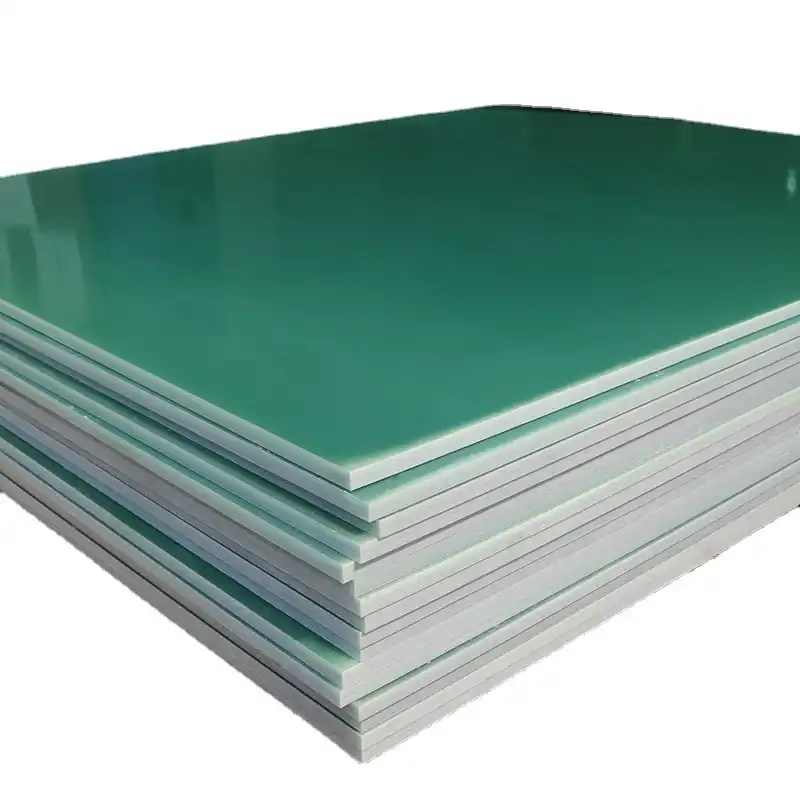What Fire Safety Standards Does G10 Meet?
UL94 Flammability Testing for G10
The UL94 flammability test is a crucial benchmark for assessing the fire safety of materials like G10 sheet. This standardized test evaluates how materials respond to small-scale flame exposure. G10 typically achieves a UL94 HB rating, indicating it burns slowly when tested in a horizontal position. This rating suggests that while G10 is not entirely flame-retardant, it does possess some inherent resistance to rapid flame spread.
Comparative Fire Performance of G10 and FR4
When comparing G10 to its flame-retardant counterpart FR4, significant differences in fire performance become apparent. FR4, which incorporates specific flame-retardant additives, usually achieves a UL94 V-0 rating. This rating indicates that FR4 extinguishes quickly after flame removal and does not produce flaming droplets. G10, lacking these additives, cannot match this level of flame resistance. However, G10's performance may still be adequate for applications where strict flame retardancy is not a primary concern.
International Fire Safety Certifications for G10
Beyond UL94, G10 sheet may be subject to various international fire safety certifications depending on its intended use. These might include standards set by organizations such as the International Electrotechnical Commission (IEC) or the European Committee for Standardization (CEN). While G10 may not meet the most stringent requirements of these standards without modification, its baseline fire performance characteristics are often sufficient for many industrial and commercial applications where moderate heat resistance is required.
Flame Resistance and Heat Tolerance in Industrial Settings
G10's Performance in High-Temperature Environments
G10 sheet exhibits remarkable heat tolerance, making it suitable for various high-temperature industrial applications. Its glass-reinforced epoxy structure allows it to maintain its mechanical and electrical properties at elevated temperatures. G10 typically has a continuous operating temperature range up to 130°C (266°F), with short-term exposure capabilities reaching even higher temperatures. This heat resistance contributes to its popularity in electrical insulation, mechanical components, and structural parts in industries where thermal stability is crucial.
Chemical Composition Impact on Flame Behavior
The chemical composition of G10 sheet plays a significant role in its flame behavior. The epoxy resin matrix, while combustible, chars when exposed to flame, creating a protective barrier that slows further burning. The glass fiber reinforcement, being inorganic, does not support combustion and helps maintain structural integrity even as the resin matrix degrades. This synergistic effect between the resin and fibers contributes to G10 sheet's moderate flame resistance, despite not being classified as a flame-retardant material.
Enhancing G10's Flame Resistance for Specific Applications
For applications requiring improved flame resistance, G10 can be modified or treated to enhance its fire performance. Techniques such as incorporating flame-retardant additives into the resin system or applying flame-retardant coatings can significantly improve G10's fire safety characteristics. These modifications can help G10 meet more stringent fire safety standards, potentially achieving ratings similar to FR4 while retaining the desirable mechanical and electrical properties that make G10 valuable in industrial settings.
Applications Requiring Flame-Retardant Fiberglass Composites
Electrical and Electronics Industry Usage
In the electrical and electronics industry, flame-retardant fiberglass composites are indispensable. While standard G10 finds use in less critical applications, industries often opt for FR4 or modified G10 variants in high-risk scenarios. These materials are crucial for printed circuit boards (PCBs), electrical insulators, and switchgear components. Their flame-retardant properties help prevent the spread of fire in the event of electrical faults, enhancing the overall safety of electronic devices and electrical systems.
Aerospace and Transportation Sector Requirements
The aerospace and transportation sectors demand materials with exceptional flame resistance due to stringent safety regulations. In these industries, modified G10 sheet or specialized flame-retardant composites are used for interior panels, structural components, and insulation materials. These applications require materials that not only resist flame spread but also generate minimal smoke and toxic gases when exposed to fire, ensuring passenger safety in aircraft, trains, and other vehicles.
Building and Construction Material Standards
In the building and construction industry, flame-retardant fiberglass composites play a crucial role in meeting fire safety codes. While standard G10 may be suitable for some applications, many building elements require materials with enhanced flame resistance. Modified G10 or specialized flame-retardant composites are used in architectural panels, electrical enclosures, and structural reinforcements. These materials help slow the spread of fire in buildings, providing valuable time for evacuation and fire suppression efforts.
Conclusion
G10 sheet, while not inherently flame retardant, offers moderate resistance to flame spread due to its glass-reinforced epoxy composition. Its UL94 HB rating indicates slow burning characteristics, suitable for many industrial applications. However, for scenarios demanding higher fire safety standards, modified G10 or FR4 alternatives are preferable. The versatility of G10 allows for enhancements in flame resistance through additives or coatings, expanding its potential uses. Understanding G10's fire performance and limitations is crucial for selecting the appropriate material in various industrial, electrical, and structural applications where fire safety is a concern.
Contact Us
For more information about G10 sheet and its flame-resistant properties, or to discuss your specific application requirements, please contact us at info@jhd-material.com. Our team of experts is ready to assist you in finding the right material solution for your needs.






